Katie Marie's Blog
October 15, 2025
Videogame: The Haunting Depths of Soma
In the shadowy depths of the ocean, where light is scarce and silence reigns, the Soma game invites players to confront the haunting mysteries of psychological horror. This unsettling adventure takes you beneath the waves into an environment that is as beautiful as it is terrifying, crafting an atmosphere that challenges your understanding of reality. As you navigate this underwater horror, you are forced to question the nature of consciousness and identity, probing existential themes that resonate deeply within the human psyche.
Through its intricate narrative exploration, Soma not only captivates but also provokes, leaving players to ponder what it truly means to be human. Prepare to be immersed in a chilling journey that blurs the lines between mind and machine, setting the stage for an unforgettable exploration of fear and philosophy.
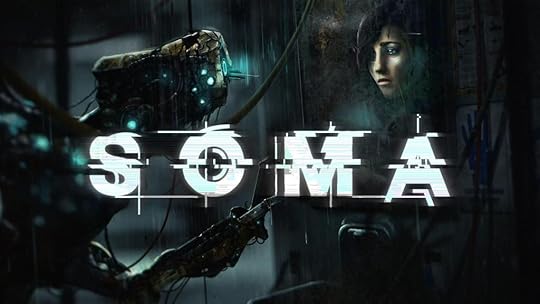 Immersive Underwater Horror
Immersive Underwater HorrorIn the Soma game, players are plunged into a world where isolation and darkness amplify fear. The game’s design leverages the vast, unknown expanse of the ocean to evoke a sense of claustrophobia and vulnerability. Players navigate through abandoned corridors and open waters, never knowing what lurks in the shadows.
The sound design plays a crucial role, with creaking metal and distant echoes enhancing the sense of dread. The absence of light further heightens the tension, making every shadow a potential threat. This sensory deprivation forces players to rely on their instincts, increasing the game’s suspense.
The underwater setting, with its unique challenges, compels players to confront their fears head-on. The experience is visceral, drawing players deeper into the narrative, where each creak and groan of the structure can signify impending danger.
Crafting the Haunting AtmosphereThe creators of Soma focused on crafting an atmosphere that is both beautiful and terrifying. Using environmental storytelling, the game conveys the history and fate of the underwater facility. Visual cues such as decaying structures and flickering lights suggest a world on the brink of collapse, offering clues to the narrative.
A careful balance is struck between realism and surrealism. The environment is meticulously detailed, with bioluminescent flora casting eerie glows, while the constant threat of being pursued keeps players alert.
The juxtaposition of serene beauty and lurking danger challenges the player’s perception of safety. The art direction contributes significantly, using color and light to evoke emotions ranging from wonder to terror. This careful crafting of atmosphere ensures players remain engaged and on edge throughout the experience.
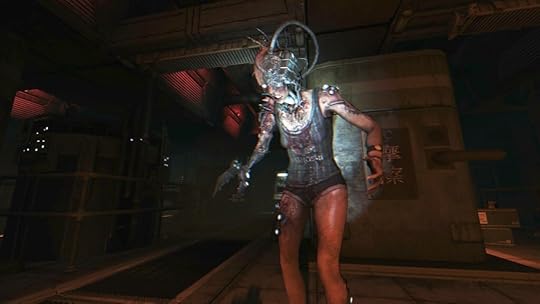 Exploring Existential Themes
Exploring Existential ThemesAt its core, Soma poses profound existential questions. The narrative forces players to confront the nature of their existence, exploring themes of consciousness and identity. Players are immersed in a world where human consciousness can be transferred to machines, blurring the lines between organic and artificial life.
The game prompts players to consider what it means to be human. Is consciousness tied to the physical body, or does it transcend it? These questions are woven into the gameplay, as players must make choices that challenge their moral and ethical beliefs.
Soma’s story is both engaging and unsettling, inviting players to ponder the implications of their actions. The existential dread it evokes is not only psychological but philosophical, leaving players with lingering thoughts long after the game ends.
Consciousness in GamesSoma’s exploration of consciousness in games sets it apart from traditional horror titles. The game’s narrative intricately examines the notion of self-awareness and the reliability of memory. Through its storytelling, players experience the fragility of identity and the impermanence of life.
The characters in Soma are not mere avatars; they are vessels through which players explore these philosophical questions. The game encourages players to question the nature of reality and their own perceptions, creating a deeply immersive experience.
As Game Developer notes, Soma’s approach to storytelling is both innovative and thought-provoking, making it a standout in the genre of psychological horror. This exploration of consciousness adds depth to the gameplay, engaging players on an intellectual level.
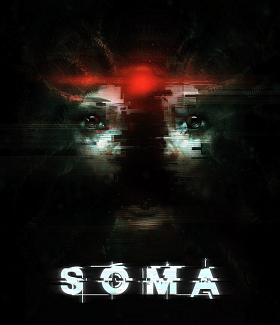 Questions of Identity and Humanity
Questions of Identity and HumanitySoma delves into questions of identity, often blurring the lines between human and machine. Players confront scenarios where identity is not just a matter of physical form, but of consciousness and memory. The narrative forces players to grapple with the notion of self and what defines an individual.
Key plot points involve the transfer of consciousness, raising questions about continuity and identity. Is a person the sum of their memories, or does their existence rely on a physical form? These themes are explored through compelling character arcs and thought-provoking scenarios.
The game challenges players to consider their own beliefs about identity, prompting introspection and self-reflection. This exploration of identity is integral to Soma’s narrative, making it a profound psychological horror experience.
The Emotional Impact of StorytellingThe emotional impact of Soma’s storytelling is undeniable. Its narrative is deeply engaging, crafting an atmosphere that evokes a range of emotions from fear to empathy. Through its characters and plot development, the game builds an emotional connection with players.
Soma’s storytelling is praised for its ability to create tension and suspense. Players are drawn into the characters’ struggles, feeling their fears and hopes. This emotional engagement is amplified by the game’s immersive environment and sound design.
Soma’s narrative is both touching and chilling, as reviewed by Corrosion Hour. It leaves a lasting impression, as players reflect on the journey long after the game has ended. The emotional depth of the storytelling ensures that Soma remains a memorable experience, resonating with players and offering a rich exploration of fear and humanity.
October 13, 2025
Famous Writers: Dean Koontz
In the shadowy realms of suspense literature and horror fiction, Dean Koontz emerges as a master storyteller whose captivating narratives leave readers on the edge of their seats. From the chilling whisper of a ghostly presence to the eerie silence before a storm, Koontz’s writing paints vivid pictures that grip the imagination. His ability to weave suspense with science fiction elements creates an enthralling blend that keeps fans coming back for more.
This post will explore Koontz’s notable works and the literary impact of Koontz himself, tracing how his evolution as a science fiction author continues to mesmerize audiences. Prepare to be intrigued as we unravel the mysteries that make his stories unforgettable.
 Blending Genres with Ease
Blending Genres with EaseDean Koontz’s novels are renowned for their genre-defying nature. He expertly combines suspense, horror, and science fiction to create stories that appeal to a broad audience. This blend allows his work to stand out in a crowded literary landscape.
Suspense: Koontz builds tension with adept pacing, keeping readers on edge.Horror: His talent for eerie, atmospheric settings creates an unsettling backdrop for his narratives.Science Fiction: He incorporates speculative elements, adding depth and intrigue to his plots.By interweaving these genres, Koontz ensures that each story is an unpredictable ride. His ability to maintain cohesion while navigating through different themes is a testament to his skill.
In novels like “Phantoms,” Koontz demonstrates how seamlessly these genres can coexist. The story combines scientific mystery with supernatural overtones, a hallmark of his style. His approach has made him a favorite among readers who enjoy a multifaceted literary experience.
Mastering Suspense and HorrorKoontz’s mastery of suspense and horror lies in his ability to invoke fear through subtlety. Rather than relying on overt scares, he uses psychological tension to unsettle readers.
His characters often find themselves in ordinary settings that quickly become sinister. This transformation is gradual, allowing readers to feel the creeping dread as reality unravels. By focusing on the psychological aspects of fear, Koontz creates a more profound sense of unease.
In “Intensity,” for example, the horror is not just in the events themselves but in the anticipation. Koontz’s manipulation of time and space within the narrative keeps readers on edge, eager yet fearful to see what comes next.
Koontz also uses character-driven narratives to amplify suspense. His protagonists often face internal and external conflicts that mirror their fears. This duality enriches the story, offering readers a deeper connection to the characters’ struggles and triumphs.
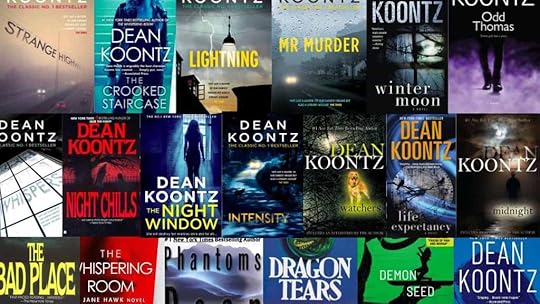 Signature Novels and Series
Signature Novels and SeriesKoontz’s bibliography includes numerous novels and series that have captivated readers worldwide. His works often feature characters on the edge of extraordinary experiences, blending ordinary lives with supernatural elements.
Odd Thomas is perhaps one of his most famous series, chronicling the life of a young man who can communicate with spirits. This series showcases Koontz’s ability to create complex, relatable characters in fantastical situations.
His standalone novels, such as “Watchers,” showcase his flair for mixing suspense with science fiction. The book’s exploration of genetic engineering and sentient beings offers readers both thrills and philosophical questions.
Koontz’s ability to write across various genres has allowed him to maintain a diverse portfolio. Each book, whether part of a series or a standalone, reflects his unique storytelling voice and keeps readers eagerly anticipating his next release.
Recurring Themes in Koontz’s WritingA common theme in Koontz’s work is the battle between good and evil, often set against a backdrop of moral ambiguity. This exploration allows him to delve into human nature and the choices that define us.
His stories frequently feature characters facing extraordinary odds, yet they often find strength in love, hope, and resilience. This focus on positive human qualities amidst dark scenarios is a hallmark of Koontz’s writing.
Another recurring theme is the exploration of the unknown. Koontz’s characters often encounter phenomena that challenge their understanding of reality, driving the narrative forward with curiosity and fear.
Ultimately, Koontz’s themes resonate with readers because they tap into universal experiences and emotions. His exploration of both the light and dark aspects of humanity provides a rich, thought-provoking reading experience.
 Influence on Suspense Literature
Influence on Suspense LiteratureKoontz’s contribution to suspense literature is significant. His ability to craft intricate plots with unexpected twists has set a high standard for the genre.
His novels are often characterized by their psychological depth, offering more than just surface-level scares. This complexity has influenced a new wave of authors seeking to blend psychological elements into suspense narratives.
Koontz’s work has also been critical in evolving the genre to incorporate more diverse themes and settings. By pushing the boundaries, he has expanded the scope of what suspense literature can achieve, inspiring both new and established writers.
Evolution Among Science Fiction AuthorsAs a science fiction author, Koontz has continually evolved, adapting his style to reflect contemporary issues. His early works often feature speculative technology and futuristic settings, yet his more recent novels blend these elements with social commentary.
Koontz’s ability to stay relevant in a rapidly changing world has earned him a respected place among science fiction writers. His novels often reflect modern-day anxieties, using science fiction as a lens to explore societal concerns.
This adaptability ensures that Koontz remains at the forefront of the genre. His continued evolution speaks to his dedication to storytelling and his desire to challenge both himself and his readers with each new work.
October 10, 2025
Fear and Resilience: The Mental Health Benefits of Engaging with Horror
In an unexpected twist, the horror genre offers more than just spine-tingling thrills; it can be a powerful tool for enhancing mental health. Engaging with horror, whether through films, books, or games, provides a unique opportunity to explore fear in a controlled setting, which can foster resilience and aid in anxiety management. This genre, often misunderstood, allows individuals to confront their own anxieties, offering therapeutic benefits that go beyond mere entertainment. Moreover, the horror community itself provides a supportive network for fans to connect over shared interests, building a sense of camaraderie and understanding.
Dive into the surprising ways therapeutic horror can empower you, enhance your well-being, and create lasting connections.
[image error]Pexels.com" data-medium-file="https://katiemariewriter.com/wp-conte..." data-large-file="https://katiemariewriter.com/wp-conte..." width="867" height="1300" src="https://katiemariewriter.com/wp-conte..." alt="" class="wp-image-13197" style="aspect-ratio:0.666924382741987;width:322px;height:auto" />Photo by David Fagundes on Pexels.comUnderstanding Therapeutic HorrorTherapeutic horror is the idea that engaging with fear in a controlled setting can be beneficial. Horror allows individuals to process emotions in a safe space. This experience can help manage anxiety, as one learns to deal with fear without real-world consequences.
Research supports the effectiveness of horror in therapy. Horror can serve as a mirror to our inner fears, helping us understand them better. The New York Times discusses how horror stories offer a unique avenue for emotional processing.
Consider these points:
Horror narratives often reflect societal fears, making them relatable.The genre’s predictability can provide a sense of control during chaotic times.Horror fosters a confrontation with the unknown, which can be empowering.Building Resilience Through FearResilience is the ability to adapt to stress and adversity. Horror can play a pivotal role in building this trait. When we engage with horror, we face fear in a controlled way, which can strengthen our psychological defenses.
Exposure: Watching horror films exposes us to fear, which can desensitize anxiety triggers over time.Reflection: Engaging with horror allows for introspection, helping us understand our reactions.Adaptation: Regular exposure to fictional fear can improve our coping mechanisms in real-life stressful situations.According to ResearchGate, horror fiction can be a therapeutic tool. By repeatedly facing fictional fears, individuals may become more resilient in reality.
[image error]Pexels.com" data-medium-file="https://katiemariewriter.com/wp-conte..." data-large-file="https://katiemariewriter.com/wp-conte..." width="831" height="1300" src="https://katiemariewriter.com/wp-conte..." alt="" class="wp-image-13199" style="aspect-ratio:0.6392370396623385;width:406px;height:auto" />Photo by Elu012bna Aru0101ja on Pexels.comConfronting Anxieties SafelyHorror provides a safe space to confront our anxieties. The controlled environment of a horror film or book allows us to explore fear without real-world repercussions. This can be an empowering experience.
Key insights include:
Horror acts as a rehearsal for handling fear and stress.It offers a way to confront and understand personal fears.Engaging with horror can reduce the stigma around experiencing fear and anxiety.Consider these benefits:
Watching horror as a group can normalize fear, reducing its power.Realizing that fear is a shared experience can be comforting.Understanding fear’s role can turn it into a useful tool rather than an obstacle.The Role of the Horror CommunityThe horror community is a vital aspect of the genre. It provides a supportive network where fans can connect over shared interests. This community is not just about a love for the macabre but also about mutual support and understanding.
Connection: Fans bond over their love for horror, forming strong social ties.Support: The community offers a space for discussing fears and anxieties openly.Diversity: Horror fans come from various backgrounds, enriching the community’s perspectives.The New York Times highlights how the horror community plays a crucial role in providing emotional support and a sense of belonging.
[image error]Pexels.com" data-medium-file="https://katiemariewriter.com/wp-conte..." data-large-file="https://katiemariewriter.com/wp-conte..." width="1733" height="1300" src="https://katiemariewriter.com/wp-conte..." alt="" class="wp-image-13196" />Photo by Felipe Hueb on Pexels.comShared Experiences and SupportShared experiences in horror can create a strong sense of camaraderie among fans. Watching a scary movie together or discussing favorite horror books fosters connection and understanding.
Consider the following:
Shared Fear: Experiencing fear together can strengthen bonds.Discussion: Post-viewing discussions allow for reflection and connection.Empathy: Understanding others’ fears builds empathy and support.In summary:
Horror can be a common ground for making friends.Sharing scares can lead to deeper, supportive relationships.The community can act as a safe space for expressing fears and anxieties.Exploring the Macabre TogetherExploring the macabre with others can be a thrilling and unifying experience. Fans often explore horror through various mediums—films, games, and literature—together, which enhances the enjoyment and connection.
Real-world examples include horror film festivals and book clubs where enthusiasts gather to explore the genre. These events foster a sense of community and shared discovery.
Key takeaways:
Festivals: Provide a platform for fans to meet and celebrate horror.Book Clubs: Encourage discussion and deeper understanding of horror literature.Online Communities: Offer a space for continuous engagement and support.In essence, exploring horror together allows fans to delve into their interests, build lasting relationships, and support each other in confronting shared fears.
October 8, 2025
Book V Film: The Ring
Koji Suzuki’s “The Ring” has long captivated audiences, weaving a tapestry of dread that transcends the written word and leaps onto the screen with haunting intensity. As we plunge into the murky depths of “The Ring comparison,” we uncover how the supernatural themes in horror are masterfully adapted from the book’s eerie pages to the film’s chilling visuals. This examination of “The Ring book vs film” will unravel the threads of character development, plot pacing, and visual storytelling that define each version’s unique approach to evoking fear. How do these mediums uniquely ensnare the imagination, and what makes each rendition a staple in horror adaptations?
Join me as we explore this dark narrative, enticing horror enthusiasts and fans of supernatural tales to see which form of Suzuki’s vision strikes the deepest fear.
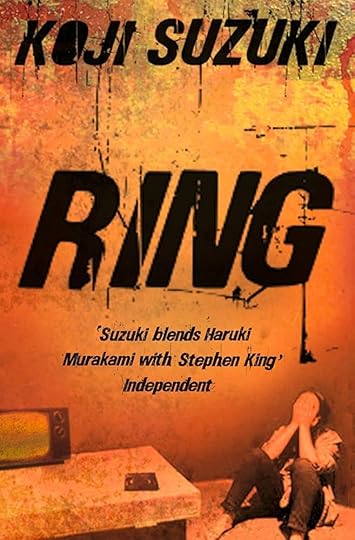 Koji Suzuki’s Original Characters
Koji Suzuki’s Original CharactersKoji Suzuki’s novel introduces readers to a rich tapestry of characters that are both relatable and complex. The protagonist, Asakawa, is a determined journalist whose curiosity drives the narrative forward. His character is meticulously fleshed out through internal monologues and vivid descriptions, which provide insight into his motivations and fears.
Supporting characters, such as Ryuji, play pivotal roles in adding depth to the storyline. Ryuji’s mysterious past and peculiar demeanor create a sense of intrigue and foreboding. These characters are not only vessels for the plot but also reflections of human nature when faced with the supernatural.
The antagonist, Sadako, is a haunting presence whose backstory is unveiled gradually. Her character is shrouded in mystery and dread, embodying the supernatural themes that define the novel. This careful characterization ensures that readers are drawn into the chilling world Suzuki has crafted.
Film’s Unique Character AdaptationsIn the film adaptation, character development takes on a different dimension. The character of Asakawa, renamed as Reiko, is portrayed with a heightened sense of urgency and emotional vulnerability. This change allows viewers to empathize with her journey on a visceral level, enhancing the tension throughout the film.
Ryuji’s character also undergoes adaptation. His portrayal in the film emphasizes his connection to the supernatural, subtly foreshadowing the film’s climactic revelations. This adaptation adds layers of complexity to his relationship with Reiko, creating a dynamic that is both engaging and suspenseful.
Sadako, the film’s central figure of horror, is presented with visual and auditory elements that enhance her menacing aura. Her on-screen presence is a testament to the power of visual storytelling in horror, as every appearance captures the essence of fear that Suzuki intended in his novel. These adaptations make the film both a faithful and innovative rendition of the original story.
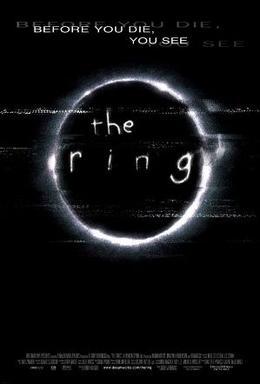 Narrative Flow in the Novel
Narrative Flow in the NovelThe novel’s narrative flow is deliberately paced to build suspense gradually. Suzuki employs a methodical approach, unfolding the mystery through detailed investigation and character introspection. This slow burn technique allows readers to immerse themselves deeply into the eerie atmosphere of the story.
Suzuki uses descriptive language to create a sense of impending doom. Each chapter carefully layers tension, with revelations and surprises strategically placed to keep readers on edge. This pacing ensures that the novel’s climax is both satisfying and terrifying.
The use of flashbacks and shifting perspectives enriches the narrative, offering readers glimpses into the past that explain the present horror. This technique not only adds depth to the story but also keeps readers guessing about the outcome, maintaining suspense throughout.
Cinematic Timing in the MovieIn contrast to the novel, the film employs a faster-paced approach to maintain viewer engagement. The cinematic timing is crafted to deliver immediate thrills and chills, with rapid cut scenes and suspenseful music heightening tension.
The film’s opening sequence swiftly establishes the stakes, setting a brisk narrative pace from the outset. This approach differs from the novel’s gradual build-up, making the film adaptation more accessible to audiences seeking quick scares.
Key plot points are revealed through visual cues and dramatic dialogue, ensuring that the tension remains palpable. The film’s ability to condense the novel’s intricate plot into a concise format demonstrates the effectiveness of visual storytelling in maintaining suspense.
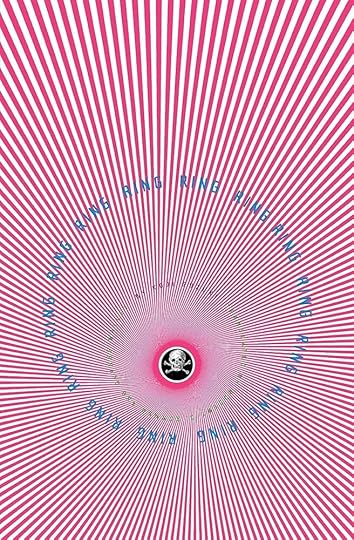 Creating Visual Horror on Screen
Creating Visual Horror on ScreenThe film adaptation of “The Ring” utilizes visual elements to create a haunting atmosphere that lingers long after the credits roll. Dark, moody cinematography sets the tone, with the use of shadows and dim lighting amplifying the sense of dread.
Special effects and practical makeup bring the supernatural elements to life, particularly in scenes involving Sadako. Her iconic emergence from the television is a masterclass in visual horror, combining suspenseful timing and eerie sound design to evoke terror.
The film’s settings, from urban landscapes to isolated cabins, are chosen to reflect the themes of isolation and fear. These carefully crafted visuals ensure that the film resonates with viewers, capturing the essence of Suzuki’s supernatural world.
Supernatural Themes in Book and FilmBoth the book and film excel in exploring supernatural themes, though they do so through different mediums. In the novel, Suzuki uses descriptive language and symbolism to convey the eerie and the otherworldly. His words create vivid images that haunt readers’ imaginations.
The film adaptation translates these themes into visual and auditory experiences. Sound effects and music play a crucial role in establishing an atmosphere of tension and unease. The eerie soundtrack complements the film’s visuals, enhancing the supernatural elements.
The presence of technology as a conduit for horror is a theme that both the book and film explore. In the novel, it’s the cursed videotape that spreads fear, while the film uses this concept to create iconic visual sequences. Both mediums effectively capture the supernatural essence, making “The Ring” a staple in horror adaptations.
October 7, 2025
Success, Spelling, and Subtitles: My Life with Dyslexia
Here in the UK, its Dyslexia Awareness Week.
I wrote a little ditty about my experience with dyslexia for my work’s Equality and Inclusion Network. I thought I’d repost it here as it is a message that’s very important to me.
You can have dyslexia and be successful; one does not obliterate the other.
Success, Spelling, and Subtitles: My Life with Dyslexia (and Why That’s Not a Contradiction)“You can’t be dyslexic,” an old boss once told me, with a genuinely confused look on their face. “You’ve got a law degree.”
Ah, yes, because obviously, dyslexia and academic achievement are like oil and water, cats and cucumbers, Piers Morgan and humility, totally incompatible.
Except… they’re not. At all.
Let’s get something straight: dyslexia is more than a cute little spelling hiccup. Sure, spelling can be involved; I’ve personally committed war crimes against the English language. But dyslexia is more than mixing up ‘their’ and ‘there’ (and sometimes ‘thier,’ let’s be honest).
Dyslexia can mean difficulty processing auditory information (yep, I’m that person who watches films in their native language with the subtitles on). It can mean struggling to tell left from right (my Satnav gets yelled at a lot in my car). It can mean working memory issues, like your brain is running too many tabs at once and crashing the system. Grammar? Makes as much sense to me as a cat trying to do long division. Reading takes longer, so does writing, and sometimes my brain helpfully decides to swap words around mid-sentence or hide them completely to keep me on my toes.
And yet, here I am.
I do have a law degree, I even tacked on a Master’s degree, because why not double down on the chaos? I spent nearly a decade working as a Legal Executive, and currently I work in Business Intelligence surrounded by spreadsheets, policies and data. In my spare time (ha, ha), I’m pursuing a PhD in literature and creative writing.
[image error]Pexels.com" data-medium-file="https://katiemariewriter.com/wp-conte..." data-large-file="https://katiemariewriter.com/wp-conte..." width="1880" height="1287" src="https://katiemariewriter.com/wp-conte..." alt="" class="wp-image-13643" />Photo by Pixabay on Pexels.comBut let’s be clear: my journey was not smooth (it still isn’t). I didn’t sail through school with colour-coded notes and A+ exam scores. I crawled, resat exams, occasionally kicked, and frequently cried. I got very familiar with the phrase “you just need to try harder,” as if I were lounging on a chaise longue while everyone else worked hard.
And that’s my point. The struggle wasn’t with the work; it was with people not understanding the way my brain works. Because dyslexia looks different for everyone, it’s not a single, cookie-cutter diagnosis; it’s a spectrum of quirks, strengths, and challenges, and everyone’s version of it is their own unique flavour of spicy chaos.
But here’s the truth I want everyone to know: Dyslexia is not a barrier to success.
Success doesn’t come in one shape or form. It’s not just degrees and job titles (although yes, we can do those too), success might be:
Building your own side hustle from the ground upRaising kind, emotionally intelligent kidsCreating incredible art, music, or storiesBeing the go-to problem solver on your teamLearning a new skill despite people saying you can’tSimply getting through a tough day with your head held highSuccess is personal; it’s whatever feels like growth to you, and dyslexia cannot stop you. It can make it more complicated, but it alone cannot stop us.
So, the next time someone says, “You can’t do X, you’re dyslexic,” or “You can’t be dyslexic, you’ve done X,” smile and say: “You clearly have no idea how brilliant dyslexic brains can be.”
Then go back to doing amazing things, with the subtitles on, of course.
October 6, 2025
Board Game Review: Why Nyctophobia is a Must-Have for Horror Enthusiasts
In the ever-evolving world of board games, “Nyctophobia” stands out as a thrilling experience for horror enthusiasts and casual players alike. This innovative board game transports you into a chilling narrative where you’re pursued by a relentless foe, all while navigating the game blindfolded. Discover how this game combines tactile exploration with suspenseful gameplay to create a unique and memorable experience.
Join me as we explore the spine-tingling elements that make Nyctophobia gameplay an essential addition to your collection.
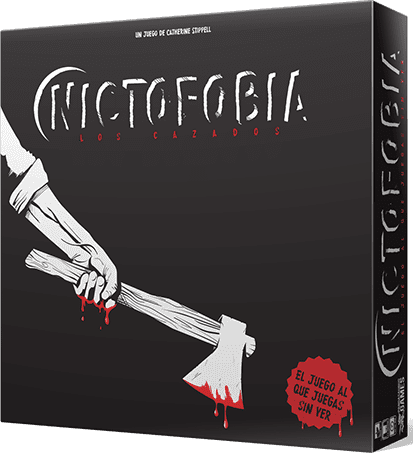 Immersive Horror Experience
Immersive Horror ExperienceNyctophobia expertly crafts an immersive horror experience by placing players in a unique setting where sight is not an option. Instead, the game emphasizes touch, sound, and cooperative strategy to navigate the board, enhancing the sense of suspense and vulnerability. This board game review explores how these elements come together, creating an atmosphere that keeps players on edge.
As players feel their way through the dark forest, the game’s innovative use of blindfolds ensures that each turn is filled with tension. This approach hones in on the fear of the unknown, capitalizing on the absence of visual information to amplify anxiety.
Many have praised Nyctophobia for its ability to transform a basic gaming session into a chilling encounter. GameDork’s Corner describes it as “a game that uniquely blends horror and strategy,” highlighting its prowess in delivering a spine-tingling experience.
Unique Game MechanicsNyctophobia’s mechanics offer a fresh take on traditional board games. The reliance on sensory deprivation sets it apart, challenging players to rethink their strategies. The game board is uniquely designed to be explored through touch, fostering a sense of discovery and curiosity.
Players navigate as a group, feeling their way through obstacles represented by small, tactile pieces. This hands-on exploration adds an element of surprise, as players must adapt to the unexpected paths and hidden threats.
The Vampire Encounter expansion enhances these mechanics, introducing new challenges and foes. This keeps the gameplay fresh and engaging, encouraging players to delve deeper into the world of Nyctophobia.
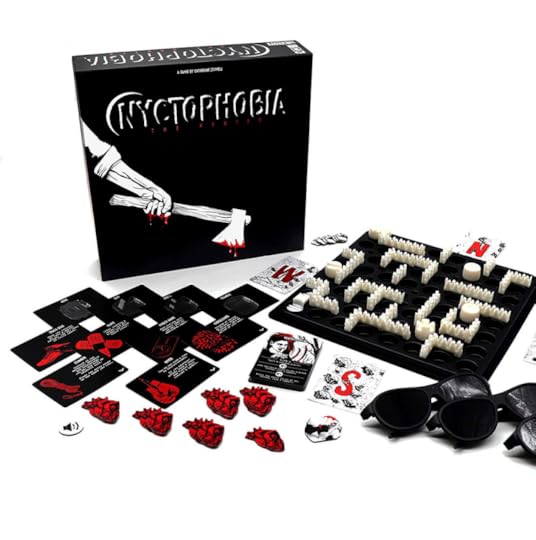 Thrilling Player Dynamics
Thrilling Player DynamicsThe dynamics between players are central to Nyctophobia’s appeal. The game encourages collaboration as players work together to evade a relentless pursuer. Communication is key, as players must share information and coordinate their movements without seeing the board.
This cooperative aspect fosters teamwork and camaraderie, as players rely on each other to survive. The Cardboard Herald notes how “the tension escalates as players inch closer to their goal,” emphasizing the collective effort required.
The predator’s role introduces a competitive edge, creating a cat-and-mouse dynamic that heightens the stakes. This interplay of cooperation and competition makes each session unique and enthralling.
How to Play NyctophobiaLearning how to play Nyctophobia involves understanding its strategic elements. Here’s a step-by-step guide to get started:
Set up the game board with tactile pieces to represent the forest and obstacles.Assign roles: one player becomes the predator, while others don blindfolds as survivors.Survivors navigate by touch, communicating their findings to the group.The predator moves strategically to corner the survivors, adding pressure each turn.These steps form the backbone of the game’s tension-filled atmosphere. Miniature Market offers detailed insights into these mechanics, highlighting the balance between strategy and suspense.
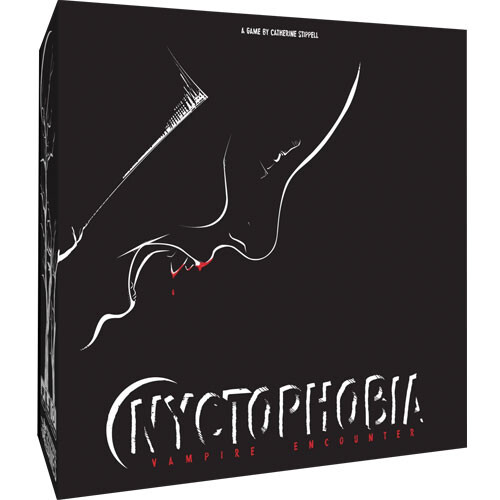 Strategies for Horror Fans
Strategies for Horror FansFor horror fans, mastering Nyctophobia involves embracing the fear and turning it to your advantage. Key strategies include:
Effective communication: Share discoveries promptly to adapt strategies.Stay calm under pressure: Panic can lead to mistakes.Utilize teamwork: Coordinate moves to outsmart the predator.These tactics help players maintain focus and cohesion, essential for surviving the game’s relentless pursuit.
Overcoming Common ChallengesChallenges in Nyctophobia primarily stem from its sensory deprivation mechanics. Overcoming these requires practice and patience. Common hurdles include:
Navigational confusion: Develop spatial awareness through repeated play.Miscommunication: Establish clear signals and terms among players.Pressure from the predator: Stay composed, using teamwork to counter their moves.Addressing these issues enhances the overall experience, allowing players to immerse themselves fully in the suspenseful atmosphere.
Why It’s Among the Best Horror Board GamesNyctophobia earns its place among the best horror board games due to its innovative design and engaging gameplay. Its use of sensory deprivation sets it apart, providing a fresh and thrilling experience compared to traditional horror games.
The game’s immersive atmosphere and strategic depth have captivated players worldwide, with many praising its ability to evoke genuine fear and excitement. This unique blend of elements solidifies its status as a must-have for horror enthusiasts.
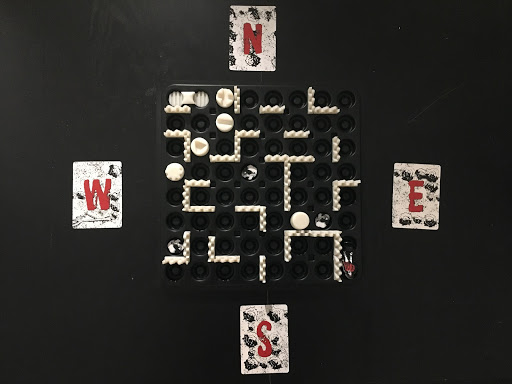 Engaging Elements That Stand Out
Engaging Elements That Stand OutWhat truly sets Nyctophobia apart are its engaging elements:
Tactile exploration: Encourages a hands-on approach to gameplay.Cooperative dynamics: Fosters teamwork and communication.Innovative mechanics: Introduces new challenges with each session.These features create a captivating experience that keeps players returning for more, eager to face the challenges and thrills Nyctophobia offers.
Final Thoughts on NyctophobiaIn conclusion, Nyctophobia is a bold and innovative entry into the world of horror board games. Its unique mechanics and engaging dynamics offer a refreshing take on the genre, providing both a challenge and an adventure for players.
For those seeking a game that combines strategy with suspense, Nyctophobia is an exceptional choice. Its ability to immerse players in a world of fear and cooperation makes it a standout title, well worth exploring for any board game enthusiast.
Ultimately, Nyctophobia’s blend of thrilling gameplay and strategic depth ensures it remains a compelling and unforgettable experience.
October 1, 2025
Horror Writing: How Funny Horror Novels Challenge Genre Conventions
In the intriguing world of literature, where the boundaries between fear and laughter are often blurred, funny horror novels have emerged as a unique subgenre that challenges traditional narratives and genre conventions. These horror comedy books (which blend the spine-chilling elements of horror with the unexpected lightness of comedy) offer a fresh take on what it means to be scared, often using parody in horror to critique societal norms and expectations. As dark comedy literature gains traction, it invites readers to reflect on the absurdities of fear through a lens of humor, thereby reshaping their understanding of terror itself.
This exploration of the best horror comedies not only entertains but also serves as a medium for deeper societal commentary (as seen in works that simultaneously terrify and amuse). For both seasoned horror genre enthusiasts and aspiring authors, the rise of humorous horror stories presents an opportunity to engage with narratives that defy convention and provoke thoughtful discourse.
[image error]Pexels.com" data-medium-file="https://katiemariewriter.com/wp-conte..." data-large-file="https://katiemariewriter.com/wp-conte..." width="972" height="1300" src="https://katiemariewriter.com/wp-conte..." alt="" class="wp-image-13166" style="aspect-ratio:0.7477058169552846;width:343px;height:auto" />Photo by Ellie Burgin on Pexels.comDefining Funny Horror NovelsFunny horror novels are a unique blend of two seemingly opposite genres—horror and comedy. These books combine the thrill of horror with comedic relief, offering a refreshing take on traditional scary stories.
Humor in horror novels often comes from character interactions, unexpected situations, or witty dialogue. This blend keeps readers on their toes, balancing fear with laughter.
What makes these novels stand out is their ability to address serious themes while maintaining an entertaining tone. Through humor, authors critique society and explore human nature, making readers think beyond the plot.
Parody in Horror: A Closer LookParody in horror serves as a tool to critique and reflect on genre clichés. By exaggerating certain aspects, authors highlight the absurdities often found in traditional horror tropes.
In a parody, familiar scenarios are twisted, creating an engaging narrative that invites laughter. This approach not only entertains but also encourages readers to question the conventions they’ve come to expect from horror stories.
Parody enriches the genre, offering fresh interpretations and challenging norms. It pushes boundaries, ensuring the horror comedy subgenre remains dynamic and relevant.
[image error]Pexels.com" data-medium-file="https://katiemariewriter.com/wp-conte..." data-large-file="https://katiemariewriter.com/wp-conte..." width="867" height="1300" src="https://katiemariewriter.com/wp-conte..." alt="" class="wp-image-13170" style="aspect-ratio:0.666924382741987;width:308px;height:auto" />Photo by Daisy Anderson on Pexels.comWhy We Love Horror ComediesThe best horror comedies captivate us by delivering a unique blend of suspense and humor. They allow readers to experience fear in a more lighthearted context, making the genre accessible to a wider audience.
These stories often feature relatable characters who navigate absurd situations, providing both entertainment and a sense of connection.
The blend of horror and comedy also serves as an emotional release, allowing readers to confront fears while enjoying a good laugh. This duality is why horror comedies hold such lasting appeal.
Dark Comedy Literature: Blurring LinesDark comedy literature blurs the lines between horror and comedy, offering narratives that are both engaging and thought-provoking. This subgenre uses humor to address dark or taboo topics, creating a nuanced reading experience.
Through carefully crafted dialogue and situations, dark comedy challenges readers to see beyond surface-level horror.
These stories often tackle societal issues, using humor to make complex themes more digestible and relatable. This approach not only entertains but also encourages critical thinking.
[image error]Pexels.com" data-medium-file="https://katiemariewriter.com/wp-conte..." data-large-file="https://katiemariewriter.com/wp-conte..." width="867" height="1300" src="https://katiemariewriter.com/wp-conte..." alt="" class="wp-image-13168" style="aspect-ratio:0.666924382741987;width:401px;height:auto" />Photo by Stephanie Lima on Pexels.comTips for Aspiring AuthorsUnderstand your audience: Consider who you’re writing for and what they enjoy in horror and comedy.Balance tone: Ensure that neither humor nor horror overshadows the other; they should complement each other.Develop strong characters: Create characters that are relatable yet capable of handling both comedic and terrifying situations.Use humor wisely: Insert humor in places that enhance the story, not detract from the tension.Experiment with scenarios: Play with unexpected situations to keep the narrative fresh and engaging.Balancing Humor and SuspenseBalancing humor and suspense in a funny horror novel is key to maintaining reader interest. Here are some strategies to achieve this equilibrium:
Timing is everything: Use humor to diffuse tension at strategic points in the story, keeping readers engaged without diminishing suspense.Juxtapose scenes: Contrast lighthearted moments with darker scenes to maintain a dynamic narrative flow.Maintain character consistency: Ensure characters react realistically to both humor and horror, grounding the story in relatable emotions.Experiment with pacing: Alternate between fast-paced, intense scenes and slower, humorous ones to create a rhythm that captivates readers.By mastering these techniques, authors can craft horror comedy books that entertain and provoke thought, ensuring lasting impact.
September 29, 2025
Katie Recommends: Finnegan
Usually, I use this space to recommend a great book, an inspiring creator, or a film I think you’d love. But today, I’m recommending something a little different.
I’m recommending one of my cats.

His name is Finnegan. He’s an adorable little butt-head, a devil in disguise if you will. He creates chaos at every opportunity, whether it’s distracting me when I should be writing, headbutting my laptop during meetings, or unleashing general feline mischief around the house.
But he’s also incredibly cute. And somehow, his chaos always makes the day a little lighter.
So today, Finnegan gets my recommendation. Because sometimes, what you need most isn’t a new book or a film, it’s a small creature reminding you to pause, stretch, and take up space unapologetically.



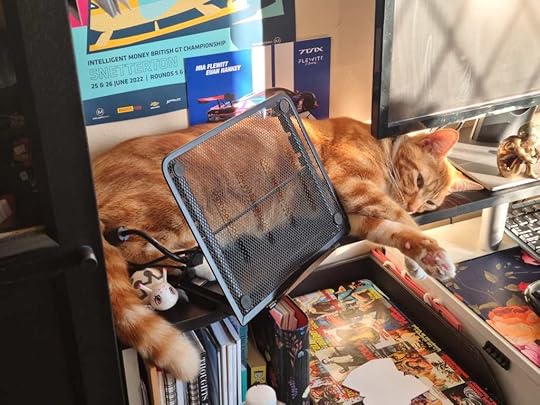
September 26, 2025
Videogame Review: Echoes of the Living
In the flickering shadows of nostalgia, “Echoes of the Living” emerges as a chilling tribute to the spine-tingling 90’s horror games that defined a generation. As survival horror enthusiasts and fans of supernatural tales, prepare to be drawn into a labyrinth of dread and discovery where every corner whispers echoes of classic survival horror. With a focus on visual horror and a reimagined approach to horror game design, this new title invites players to unravel the enigma of a haunting incident that unfolds with every step. What secrets lie hidden in the murky depths of this digital nightmare, and how will you navigate the intricate horror game mechanics that bring this chilling world to life?
Join me as we delve into the eerie corridors of “Echoes of the Living,” where gaming nostalgia meets a terrifying new frontier.
 Nostalgic Echoes in Gaming
Nostalgic Echoes in GamingNostalgia is a powerful tool in gaming, serving as a bridge between generations. “Echoes of the Living” taps into this by recalling the ambiance and soundscapes that characterized 90’s horror games. Players will find themselves immersed in environments that echo the eerie silence and sudden frights of classics like “Resident Evil” and “Silent Hill.”
Auditory cues play a significant role in this nostalgia. The game uses minimalistic sound design to heighten tension. Subtle background noises and sudden audio spikes mimic the unpredictable nature of the original titles.
Furthermore, visual elements such as dimly lit corridors and unsettling camera angles contribute to a sense of foreboding. These design choices are deliberate, aiming to remind players of the claustrophobic settings prevalent in 90’s horror games.
The developers have created a world that feels both familiar and new. By blending nostalgic elements with modern graphics, they maintain the integrity of the classic survival horror experience. Gamers can expect a thrilling journey that respects its roots while offering fresh horror narratives.
The Essence of Classic Survival HorrorThe core of classic survival horror lies in its ability to instill fear through vulnerability. “Echoes of the Living” captures this essence by emphasizing limited resources and unpredictable threats. This game design choice forces players into strategic decision-making, heightening emotional investment.
The game limits weapon availability and ammunition, compelling players to weigh their choices carefully. This scarcity mirrors the challenges faced in early horror games, where each decision could mean life or death.
Environmental storytelling is another hallmark of this genre. In “Echoes of the Living,” every location tells stories through its design and the objects scattered within. Abandoned rooms and cryptic notes serve as narrative devices, providing context and deepening the mystery.
Moreover, the game leverages psychological horror by creating enemies that embody players’ fears. These creatures are designed not just to challenge but to unsettle, echoing the psychological depth of the 90’s classics.
By synthesizing these elements, “Echoes of the Living” delivers a genuine survival horror experience. It respects the genre’s foundations while evolving its storytelling and gameplay to engage a modern audience.
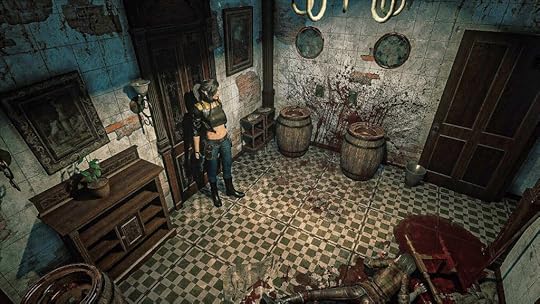 Modern Takes on 90’s Aesthetics
Modern Takes on 90’s AestheticsModern technology allows “Echoes of the Living” to elevate the visual experience. By using advanced rendering techniques, the game presents detailed environments that retain the charm of 90’s horror games. Shadows, textures, and lighting are meticulously crafted to evoke a sense of dread.
The game employs dynamic lighting to create an ever-shifting atmosphere. This, combined with realistic textures, ensures that each scene is visually compelling and immersive. These elements work together to enhance the game’s cinematic quality.
Character design also plays a crucial role in visual horror. The game features grotesque creatures that are both terrifying and artistically inspired. These designs draw from 90’s horror archetypes while introducing new, unsettling details.
Furthermore, the use of fixed camera angles pays homage to the classic style. This choice not only amplifies tension but also challenges players to adapt their strategies, keeping them on edge.
Ultimately, “Echoes of the Living” reimagines visual horror by honoring its roots while utilizing cutting-edge graphics. This balance ensures a visually arresting experience that captivates both nostalgic players and newcomers.
Immersive Horror Game DesignImmersive design is central to “Echoes of the Living,” where every aspect of the game world contributes to the horror experience. From audio to visuals, each element is crafted to draw players deeper into the game’s unsettling narrative.
Sound design is pivotal in creating immersion. The game uses ambient noises and carefully timed sound effects to build tension. This approach makes players acutely aware of their surroundings, heightening their sense of vulnerability.
The environmental details are equally important. “Echoes of the Living” presents richly detailed settings that feel lived-in and authentic. Each location is meticulously designed to enhance the narrative, encouraging exploration and discovery.
Interactive elements further engage players. The game includes puzzles and interactive sequences that require players to manipulate their environment. These mechanics are designed to immerse players fully, making the horror experience more personal.
By integrating these design elements, “Echoes of the Living” ensures an immersive experience. Players are not mere spectators but active participants in a horror narrative that feels both compelling and haunting.
 Gaming Nostalgia and Innovation
Gaming Nostalgia and Innovation“Echoes of the Living” successfully combines nostalgia with modern innovations to enhance the horror experience. By revisiting classic survival horror mechanics, the game taps into familiar patterns while introducing novel twists.
Inventory management is a key mechanic, reminiscent of 90’s games where players had to strategically allocate limited resources. This approach demands thoughtful planning, intensifying the suspense.
However, the game also introduces modern innovations such as updated user interfaces and intuitive controls. These enhancements make the game accessible to new players while preserving the challenge for veterans.
Adaptive AI is another innovative feature. Enemies learn from player actions, ensuring that encounters remain unpredictable. This evolving challenge keeps players engaged, requiring them to adapt constantly.
Overall, “Echoes of the Living” adeptly balances nostalgia with innovation. By refining and expanding upon traditional mechanics, it delivers a cohesive and engaging survival horror experience that resonates with diverse audiences.
Crafting Suspense Through Game MechanicsSuspense is at the heart of “Echoes of the Living,” meticulously crafted through its game mechanics. Each aspect is designed to keep players on edge, creating a tense and immersive horror experience.
Resource Scarcity: Limited supplies force players to make strategic decisions, amplifying the stakes and consequences of each choice.Environmental Puzzles: Challenging puzzles integrate seamlessly into the game world, requiring players to solve them under pressure, reinforcing a sense of urgency.Dynamic Threats: The game features unpredictable enemy encounters that adapt to player actions, ensuring that danger feels imminent and unavoidable.Narrative Integration: The storyline unfolds through gameplay, with each mechanic serving as a narrative device that deepens the player’s emotional investment.By combining these mechanics, “Echoes of the Living” masterfully crafts suspense. Players are drawn into a world where each action matters, and every decision is fraught with potential peril. This intricate design ensures a gripping and memorable horror experience.
September 24, 2025
Film Review: Hold Your Breath and Its Reflection of Contemporary Anxieties in Psychological Horror
In the dimly lit corridors of the cinematic landscape, psychological horror stands out as a genre that uniquely explores the depths of human fear and societal anxiety (often revealing more about our collective psyche than we might be comfortable admitting).
“Hold Your Breath,” a 2024 film directed by the adept duo of Karrie Crouse and Will Joines, emerges as a poignant example of this genre’s potential to mirror contemporary anxieties. By weaving an intricate narrative that delves into the haunting nature of fear and isolation, the film not only captivates horror enthusiasts but also invites critical discourse on its themes and character development (which are as intricate as they are chilling). With standout performances that bring to life the nuanced script, “Hold Your Breath” invites us to consider (and reconsider) the boundaries of psychological horror while reflecting on how these fictional fears echo real-world concerns.
Join me as we dissect this must-see masterpiece, exploring its critical reception and the underlying psychological elements that make it both a reflection of our times and a challenge to conventional horror narratives.
 Intricate Storytelling Techniques
Intricate Storytelling Techniques“Hold Your Breath” employs intricate storytelling techniques that keep audiences on the edge of their seats. The directors, Karrie Crouse and Will Joines, skillfully interweave multiple plotlines, creating a tapestry of suspense and emotion.
The film utilizes non-linear timelines to add depth to the narrative, allowing viewers to piece together the story like a puzzle.A mix of flashbacks and foreshadowing enriches the storyline, providing context and building tension.The directors also use visual storytelling to enhance the narrative. Symbolic imagery and color palettes reflect the characters’ emotional states and hint at underlying themes. This method not only engages viewers but also encourages them to delve deeper into the film’s meaning.
For more on the film’s narrative techniques, check out this page.
Unpacking Film ThemesThemes in “Hold Your Breath” are both universal and deeply personal. The film explores the haunting nature of fear and isolation, resonating with audiences on multiple levels.
Fear is depicted not just as an emotion but as a pervasive force that drives character actions and decisions.Isolation is another key theme, mirrored in both the physical and psychological landscapes of the film.The interplay of these themes creates a rich tapestry that echoes real-world societal anxieties. As viewers navigate the film, they are prompted to reflect on their own experiences with fear and solitude, making the film a powerful commentary on contemporary life.
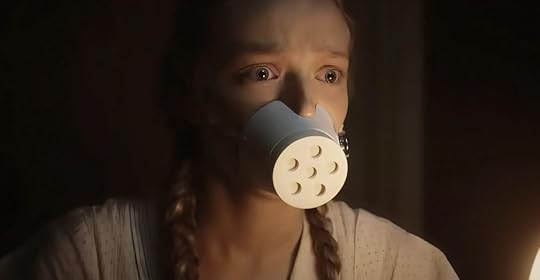 Symbolism and Contemporary Anxieties
Symbolism and Contemporary AnxietiesThe film adeptly uses symbolism to reflect contemporary anxieties. From the setting to character actions, symbolic elements are woven throughout the narrative to enhance its thematic depth.
The setting serves as a metaphor for isolation, with desolate landscapes mirroring the characters’ inner turmoil.Symbolic props and motifs reinforce themes of fear, creating a pervasive sense of dread.In a world grappling with uncertainty, these symbols resonate with viewers, inviting them to explore their own anxieties. The film challenges audiences to confront the fears that lurk beneath the surface of everyday life, making it a compelling reflection of modern societal concerns.
Evaluating Critical Reception“Hold Your Breath” received a mixed to positive critical reception, with reviewers praising its narrative complexities and thematic depth.
Critics lauded the film’s ability to weave intricate narratives while maintaining suspense and intrigue.Some reviews noted the film’s ability to challenge conventional horror tropes, offering a fresh perspective on the genre.Despite varying opinions, the film has been recognised for its ambitious storytelling and thematic exploration.



